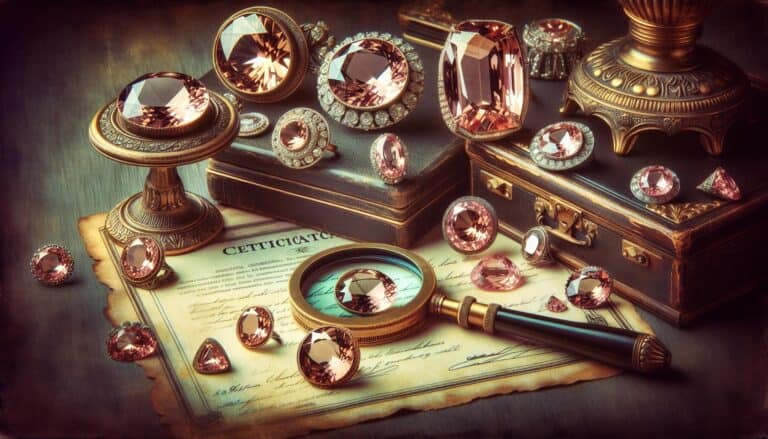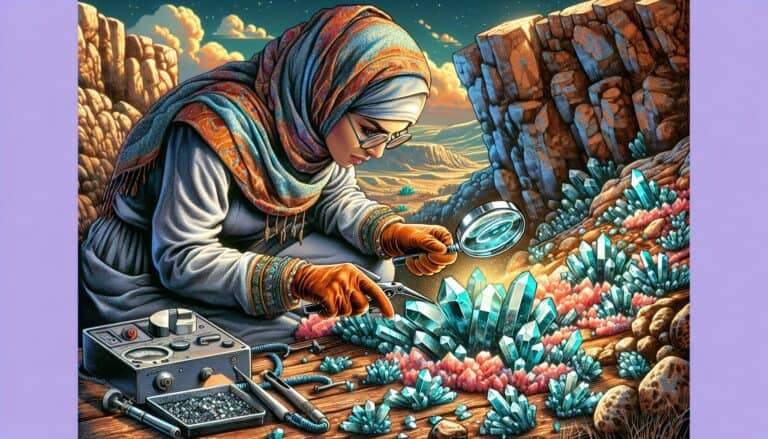If you’ve ever stumbled upon a vibrant, turquoise-hued stone and wondered if it’s chrysocolla, you’re not alone.
This alluring gemstone, with its soothing shades of blue and green, is a favorite among collectors and jewelry lovers alike. But how can you be sure you’ve got the real deal?
Knowing how to identify chrysocolla is key to adding a genuine piece to your collection. You’ll need to look out for its unique characteristics and understand what sets it apart from similar minerals.
Let’s dive into the world of chrysocolla and learn how to spot this beauty with confidence.
To identify chrysocolla, examine its turquoise to greenish-blue hue and glassy to dull luster. Perform a streak test for a light blue streak, ensure it’s non-magnetic, and note its Mohs hardness of 2.5-3.5. Chrysocolla is typically non-birefringent and has a specific gravity of 2.00 to 2.40.
How to Identify Chrysocolla Through Testing
When you’re on the hunt for chrysocolla, a few tests can confirm its authenticity. By understanding these processes, you can make informed decisions when examining potential chrysocolla specimens.
Visual Inspection
Initiate your identification with a thorough visual examination. Genuine chrysocolla boasts a distinct turquoise to greenish-blue hue often accompanied by a glassy to dull luster. Look for the presence of quartz or malachite, as chrysocolla frequently occurs in association with these minerals.
The Streak Test
Perform the streak test by rubbing the stone against unglazed porcelain tile. Chrysocolla will leave a light blue to blue-green streak, which is a good indicator of its authenticity. If the streak color significantly deviates from this range, you’re likely dealing with an imposter.
Magnet Test
Though chrysocolla itself is not magnetic, it can contain minor iron impurities. Pass a strong magnet over the stone – a slight attraction could suggest the presence of such impurities, commonly found in authentic chrysocolla.
Hardness Test
Using the Mohs scale of mineral hardness, chrysocolla should fall between 2.5 to 3.5. Test its hardness by trying to scratch it with common items like a penny or a fingernail. If it easily scratches, it could indeed be chrysocolla.
Birefringence Test
Chrysocolla is typically non-birefringent, meaning it shouldn’t show double refraction when viewed under a polariscope. If you observe birefringence, the specimen might be a different mineral altogether.
Checking The Diaphaneity
Hold the stone up to a light source. Chrysocolla’s diaphaneity ranges from translucent to opaque. A transparent specimen is a sign that you might not be looking at chrysocolla.
Single or Double Refraction
Examine your stone under a gemological microscope to see if it exhibits single or double refraction. True chrysocolla is an amorphous material and should show single refraction.
Refractive Index Test
Professional testing with a refractometer can determine the refractive index of your specimen. Chrysocolla will have a refractive index in the range of 1.575 to 1.585. Values outside of this range suggest the mineral is not genuine chrysocolla.
Finding The Specific Gravity
The specific gravity of chrysocolla is typically between 2.00 to 2.40, which is lighter than many look-alike stones. This test involves weighing the stone in air and then suspended in water to calculate its density.
Identifying Chrysocolla in the Field
Spotting chrysocolla in the field requires keen observation. Look for its vibrant colors around copper ore deposits. Its association with other minerals like malachite and azurite can also be a giveaway.
Recognizing Potential Chrysocolla Rocks
In the field, potential chrysocolla rocks may not show the classic color due to weathering or impurities. Take note of the surrounding area and any visible mineral veins; these clues can lead you towards identifying potential chrysocolla rocks.
Physical Characteristics of Chrysocolla

Chrysocolla boasts a dazzling array of physical traits that can help you identify its presence. You’ll often notice its turquoise to blue-green color, which is as captivating as it is distinctive. This unique hue is a telltale sign of chrysocolla’s rich copper content, a characteristic shared with other copper-based minerals.
The mineral’s luster ranges from vitreous to dull, depending on factors like surface weathering or the presence of impurities. What’s more, chrysocolla often presents a glossy appearance when polished, adding to its allure. Keep an eye out for this sheen when examining potential chrysocolla specimens.
In terms of texture, chrysocolla can feel smooth to waxy. If you’re handling the mineral, take note of its texture; it’s a crucial detail that can guide you toward accurate identification.
When it comes to transparency, chrysocolla usually exhibits translucence to opacity. Yet, it retains enough transparency to allow light to pass through, if only slightly, distinguishing it from more opaque minerals.
Here’s a quick rundown of chrysocolla’s typical physical characteristics:
- Color: Turquoise to blue-green
- Luster: Vitreous to dull
- Texture: Smooth to waxy
- Transparency: Translucent to opaque
Remember, while these features are indicative, always consider the full suite of tests and observations for a reliable identification.
How Are Chrysocolla Formed?
Understanding the formation of chrysocolla is crucial when you’re in the field. Chrysocolla is formed by the chemical weathering of copper ores, and it often occurs when copper-rich solutions encounter silica-rich rocks. This interaction prompts a secondary enrichment process that essentially redeposits copper in the form of chrysocolla.
Primary Sources of Formation
Chrysocolla primarily originates in the oxidation zones of copper ore bodies. Here’s what typically happens:
- Copper-bearing solutions percolate through fractures and voids.
- These solutions react with silica and other minerals in the host rock.
- Over time, with the evaporation of water, chrysocolla crystallizes.
Environmental Conditions Impacting Formation
The right conditions are everything. Temperature, pH levels, and the presence of other minerals significantly affect chrysocolla’s formation. You’ll find that:
- Warm climates accelerate the chemical reaction rates, facilitating quicker formation.
- A higher pH leads to more readily available copper ions, which are essential for chrysocolla to develop.
- The availability of water is critical since it’s necessary for the minerals to move and react.
As chrysocolla forms, it often takes on prismatic crystals or botryoidal shapes, which hints at the mineral’s environment of creation. Decompiled granite or quartz can sometimes be indicators of where chrysocolla might form, making geological knowledge an asset when identifying potential chrysocolla deposits.
- Deposits near copper mines are often lucrative spots.
- Alterations in the surrounding host rock can point to mineralization.
- Look for tell-tale signs such as quartz outcrops that may indicate chrysocolla presence.
By paying attention to these details, you increase your chances of successfully pinpointing chrysocolla-bearing areas, giving you context for the next steps in identification and verification.
Preparation for Chrysocolla Hunting
Gathering the Right Tools
Before you embark on your chrysocolla hunting adventure, having the right tools is crucial for success. You’ll need a few essentials to identify chrysocolla effectively in the field.
- Geologist’s hammer: This is a must-have for collecting samples and breaking open rocks to reveal potential chrysocolla deposits.
- Hand lens or magnifier: A key tool for close inspection of rock textures and mineral details.
- Field notebook: Essential for recording observations, locations, and characteristics of any findings.
- Safety goggles: To protect your eyes from flying rock fragments.
- GPS device or map: To navigate and mark the locations of your finds.
- Acid bottle with diluted hydrochloric acid: Helpful for testing mineral reactions, but handle with care.
Make sure all your tools are in good condition and suited for outdoor use. Quality equipment can enhance your ability to spot chrysocolla and differentiate it from similar-looking minerals.
Safety Considerations
When preparing for mineral hunting, safety should be your top priority. Here are some safety measures to always keep in mind:
- Wear sturdy footwear and protective gloves to minimize injury from sharp rocks or accidental tool slips.
- Stay hydrated and protected from the elements; carry enough water, use sunscreen, and wear a hat and long sleeves for sun protection.
- Inform someone of your plans and expected return time, especially if you are venturing into remote areas.
- Be aware of local wildlife and terrain risks; carry a first aid kit for emergencies.
By prioritizing safety and being well-prepared with the appropriate tools, you’re all set to embark on your chrysocolla hunting journey, fully equipped to identify and safely collect this captivating mineral.
Handling and Care of Found Chrysocolla

Cleaning Chyrsocollas
Once you’ve successfully identified and collected chyrsocolla, it’s crucial to clean it properly to maintain its vibrant color and luster. Start by gently rinsing your found stones in lukewarm water to remove any loose dirt or debris. Avoid using any harsh chemicals or abrasive materials that could damage the stone’s surface. You can use a soft brush, like a toothbrush, to carefully dislodge any stubborn dirt.
For stones with a significant buildup of grime, a solution of mild soap and water can be effective. Ensure you thoroughly rinse the soap off as residue can leave a film on the chyrsocolla.
Pat the stones dry with a soft cloth instead of air-drying, which can leave water spots. If you’ve found a chyrsocolla still embedded in its host rock, consult with a professional before attempting to clean it to avoid damaging the specimen.
Storing Chyrsocollas
Proper storage is vital for preserving your chyrsocolla’s condition. Wrap each piece individually in a soft cloth or place it inside a fabric-lined box to prevent scratching. Chyrsocollas are not as hard as many other gemstones, so storing them away from harder minerals is important to avoid damage.
Consider the following for optimal storage:
- Control the environment: Keep your chyrsocollas away from extreme temperatures and direct sunlight, which can cause fading over time.
- Maintain humidity levels: Too much humidity can lead to the growth of mildew or other damaging substances. A silica gel pack in the storage area can help control moisture.
- Separate by hardness: Gems are often categorized by their hardness according to the Mohs scale. Store your chyrsocollas with stones of similar hardness to prevent scratches.
- Regular check-ups: Periodically examine your stored chyrsocollas for any signs of damage or degradation.
By following these steps, you’ll help ensure that your chyrsocollas retain their beauty for years to come. Whether you’re a seasoned collector or a beginner in gem hunting, treating each find with care is the hallmark of a responsible enthusiast.
Conclusion: Confirming Chrysocolla is Real
You’re now equipped with the essentials for identifying chrysocolla in the wild.
Armed with knowledge of its physical characteristics and testing methods you can confidently distinguish this gemstone from others. Remember the importance of preparation and safety while hunting—your tools and precautions are as crucial as your identification skills. Proper handling and care will ensure that your chrysocolla pieces remain as stunning as the day you found them.
Embrace the journey of discovery and enjoy the rewards of unearthing this captivating mineral.


![Texas Rockhounding Sites in [year]: What You’ll Discover & Where](https://observationhobbies.com/wp-content/uploads/2024/01/MZHIzqyqCDorVgqMLNsPb-768x439.jpg)

![South Dakota Rockhounding Sites in [year]](https://observationhobbies.com/wp-content/uploads/2024/01/kNC8Njq0n49hZutA6mi-768x439.jpg)


![Illinois Rockhounding Sites in [year]: Best Spots & Finds](https://observationhobbies.com/wp-content/uploads/2024/01/bD90IrQO6PXFhraASvW2C-768x439.jpg)